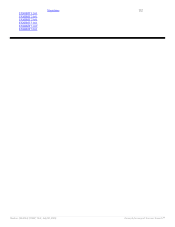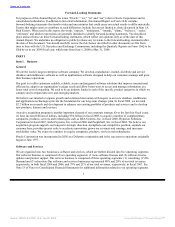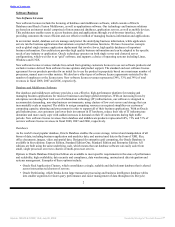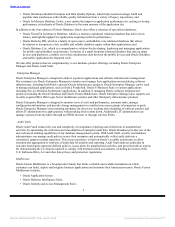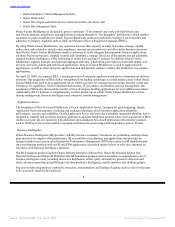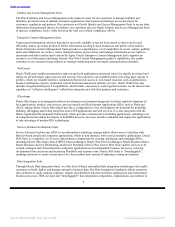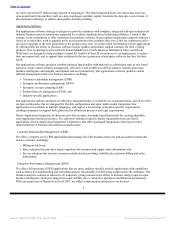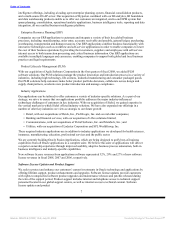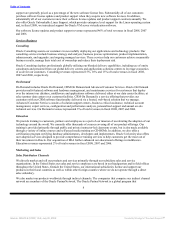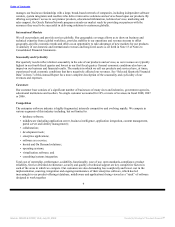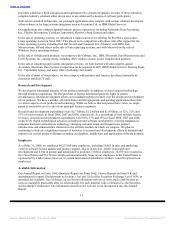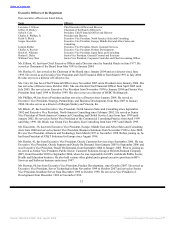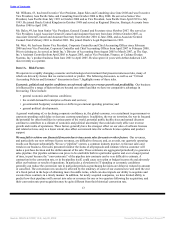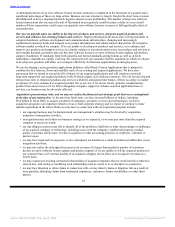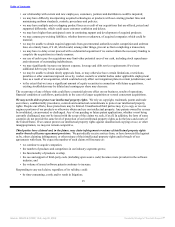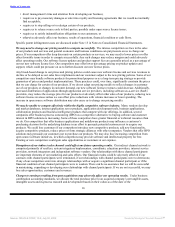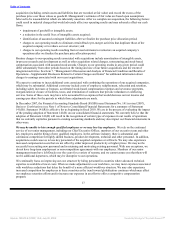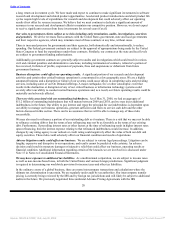Oracle 2007 Annual Report Download - page 15
Download and view the complete annual report
Please find page 15 of the 2007 Oracle annual report below. You can navigate through the pages in the report by either clicking on the pages listed below, or by using the keyword search tool below to find specific information within the annual report.
Table of Contents
Our product sales (and the relative strength of our products versus our competitors’ products) are also affected by the
broader “platform” competition between industry standard Java (J2EE) by Sun Microsystems, Inc. (Sun
Microsystems) and Microsoft Corporation’s .NET programming environments and by operating system competition
among Microsoft’s Windows Server, Unix (Sun Microsystem’s Solaris, Hewlett Packard Company’s (HP)-UX and
International Business Machines Corporation’s (IBM)-AIX) and Linux. Open source alternatives to commercial
software are also impacting the competitive environment. These products are typically offered free of charge and are
readily available over the internet. Finally, software-as-a-service (SaaS) offerings continue to alter the competitive
landscape.
The following lists of competitors are necessarily incomplete due to the nature of the enterprise software industry.
The competitive landscape is constantly evolving as firms emerge, expand, are acquired and otherwise change.
In the sale of database software, scalability, reliability, availability and security are key competitive differentiators for
us. Our competitors include IBM, Microsoft, Sybase, Inc., NCR Corporation’s Teradata division, SAS Institute, Inc.,
Informatica Corporation, and the open source databases such as MySQL (recently acquired by Sun Microsystems)
and PostgreSQL, among others. Our ability to continually innovate and differentiate our database product offerings
has enabled us to maintain our leading position in database software over our competitors.
In the sale of middleware products, our offerings include application server, business intelligence, application
integration, business process management, Service-Oriented Architecture, collaboration and content management,
portal, and identity management software. Our ability to offer a full range of rich functionality in a standards-based,
open architecture has been a key competitive differentiator. Our competitors include IBM, Microsoft, SAP AG, Sun
Microsystems, Progress Software, Fujitsu Software Corporation, Hitachi Software Engineering Co., Ltd., open
source vendors such as Red Hat, Inc. (JBoss), Apache Geronimo, and Netezza Corporation, as well as several other
competitors in each element of our packaged functions such as TIBCO Software, Inc., Software AG, Savvion, Inc.,
Microstrategy, Inc., CA, Inc., Informatica, Novell, Inc., Lombardi Software, Inc. and Pegasystems, Inc., among
others. Our middleware solutions have experienced rapid growth in recent years relative to our competitors.
In the sale of collaboration and content management products, we compete with Microsoft, IBM
(Domino/Notes/FileNet), EMC Corporation (Documentum), Open Text Corporation, Interwoven, Inc., HP (Tower
Software) and Vignette Corporation, among others.
In the sale of development tools, ease of use, standards-compliance and the level of abstraction (automated code
generation) are key competitive differentiators. We compete against IBM (WebSphere Studio), Microsoft
(VisualStudio.NET), Sun Microsystems (Sun Studio), Sybase (PowerBuilder) and others, including Eclipse
Foundation, Inc. (Eclipse), an open source vendor. The success of our development tools is closely related to the
relative popularity of our platform (database and middleware) compared to our competitors as well as the larger
competition between Java and Microsoft’s .NET.
The sale of applications software, in particular, is changing rapidly due to the development and deployment of
Service-Oriented Architectures and web services, application integration middleware as well as software as a service
offerings. As a result of our acquisitions of PeopleSoft and Siebel, we currently offer several product lines that are
suited for different needs of customers in different industries. One of the main competitive differentiators in
applications software is our ability to combine best-of-breed software, Suite software and our Application Integration
Architecture, while shielding the end user from complexities. We compete against SAP AG, Lawson Software, Inc.,
Infor Global Solutions GmbH (SSA Global Technologies, Extensity), Microsoft Dynamics (Dynamics GP, Dynamics
NAV, Dynamics CRM, Dynamics Snap, Dynamics SL), Sage, Inc., and IBM (Maximo, MOR Software, Ascential
Software) as well as many other application providers and point solution providers.
We also provide applications specific to operations in particular industry verticals, such as retailing, financial
services, communications, tax and utilities, health sciences, public sector and others. These applications are
distinguished from enterprise resource planning (ERP) or customer relationship management (CRM) in that these
industry-specific applications are focused on and limited to particular industry segments, as opposed to being
designed for broad distribution across several industries. We typically compete with commercial software vendors’
pre-packaged applications, applications developed in-house by customers, applications which were custom developed
by other software vendors and applications consisting of discrete pieces of functionality from multiple
10
Source: ORACLE CORP, 10-K, July 02, 2008 Powered by Morningstar® Document Research℠


